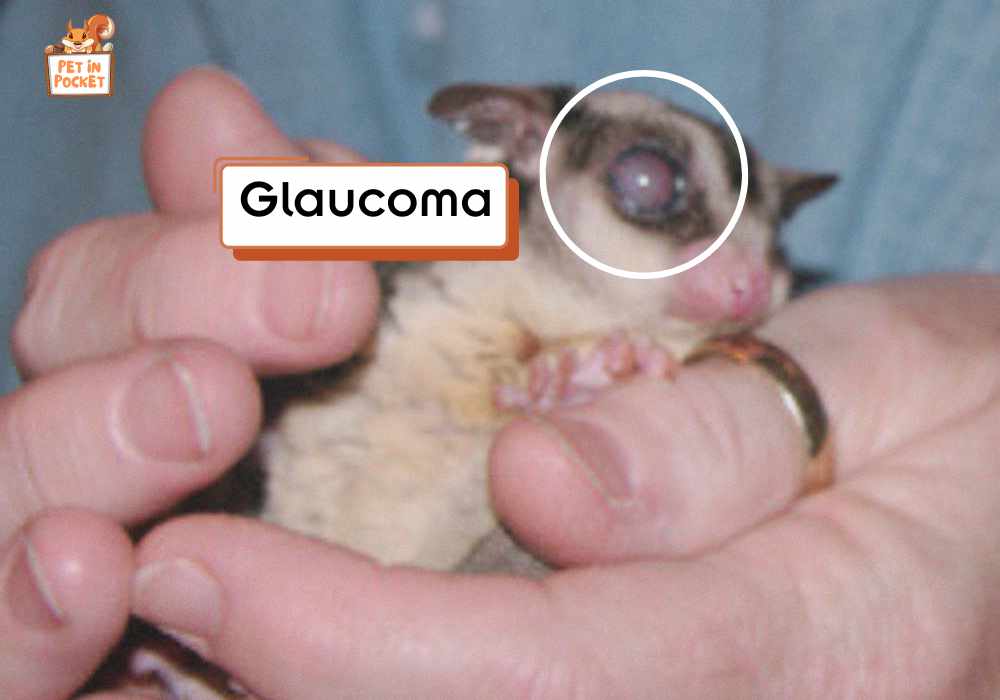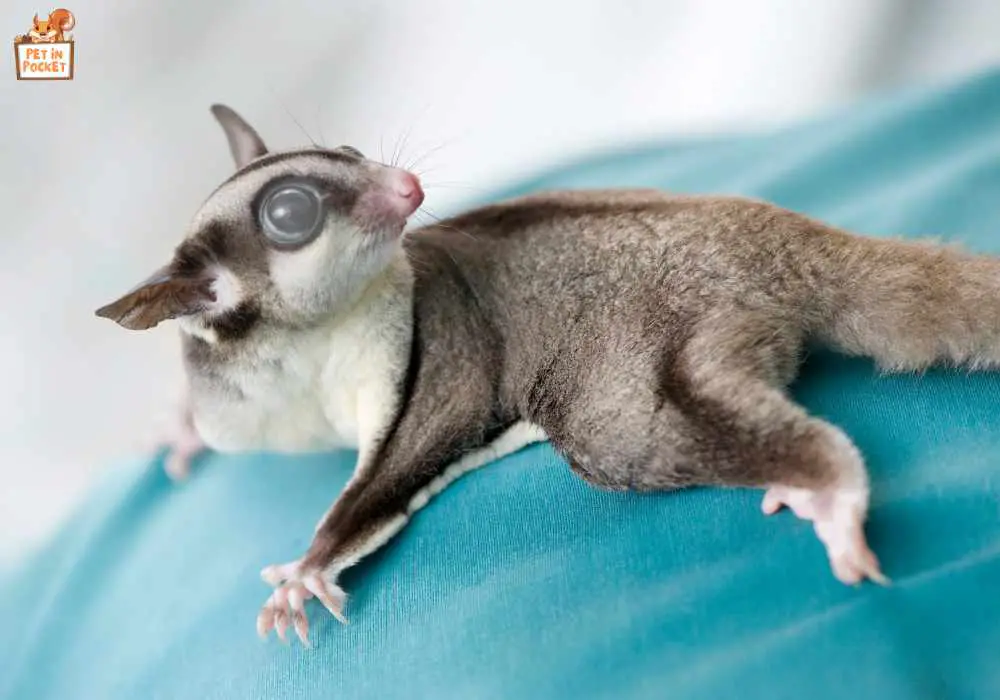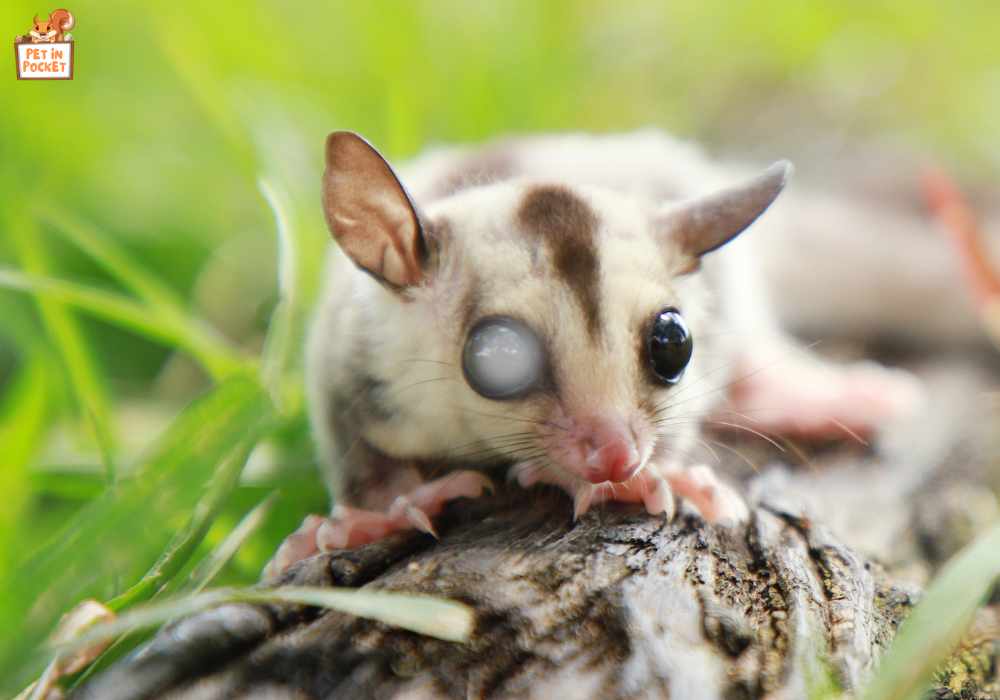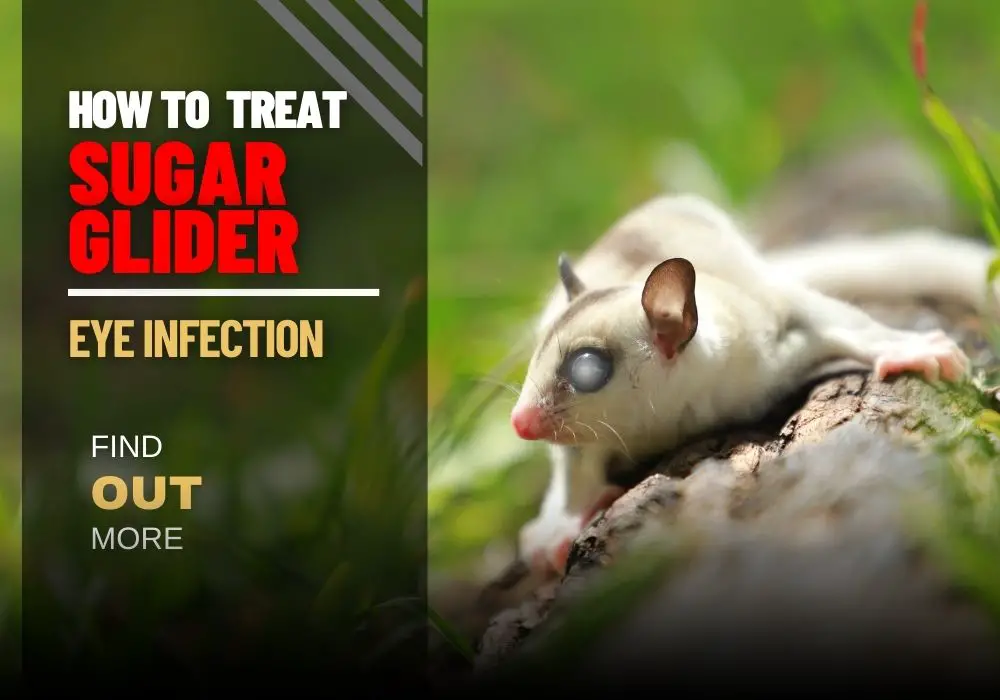Sugar gliders are delightful little creatures, and like any pet, they can encounter health issues.Very recently I notice my sugar glider squinting.I was very scared for this issue.When I go to veterinarian expert they told me that it could be a sign of an eye infection. Eye infections are relatively common in sugar gliders, and it’s essential to address them promptly.
In this blog “how to treat sugar glider eye infection” we will give you expert advice on detecting eye infection of your sugar gliders. We’ve accumulated our best list of resources to help you learn appropriately about eye infection of your sugar glider.You’ll also learn about the important role that medical care plays in keeping your sugar glider healthy. Our comprehensive suggestions will help you to insure your sugar glider lives a long and happy life with you.
Here I will inform all the sugar glider owners on a few of the most common eye conditions of sugar gliders and possible causes and treatments for these issues.
Table of Contents
Sugar Glider Eye Anatomy
Sugar gliders possess remarkable eyes that contribute to their survival in their natural habitat. Their large size, wide field of vision, and excellent night vision make them well-adapted for life in the dark. Their eyes are positioned to the sides, allowing them to see a broad area without needing to turn their heads extensively.
The eyes of sugar gliders comprise several essential parts, including the cornea, iris, lens, retina, and optic nerve. The cornea acts as a protective layer and helps focus incoming light onto the lens. The iris, similar to our own eyes, controls the size of the pupil, regulating the amount of light that enters the eye.
The lens focuses light onto the retina, which contains specialized cells that convert light into electrical signals. These signals are then transmitted to the brain via the optic nerve, allowing sugar gliders to interpret their surroundings visually.Different eye infections can attack the sugar glider very badly. Early detection and prompt veterinary attention are crucial for successful treatment. Most sugar gliders recover fully with proper care.
Overview of Eye Infections in Sugar Gliders
Eye infection is one of the most common health concerns seen in sugar gliders. These diseases might result from unfortunate cleanliness, wounds, natural stressors, or basic ailments.The indicators of eye infection include redness, discharge,and increased tearing. If left untreated, eye infections can lead to serious complications.
It is important to catch the infection early and get your sugar glider to the vet as soon as possible.With proper treatment, most sugar gliders make a full recovery from eye infection.
Eye infection Problems in Sugar Gliders
Eye infections are a frequent health concern for sugar gliders.These tiny marsupials can experience various eye problems, and it’s essential to recognize the signs and seek prompt treatment.
- Corneal Lipidosis
- Conjunctivitis
- Glaucoma
- Retrobulbar Abscess
Corneal lipidosis
Corneal lipidosis in sugar gliders refers to the accumulation of lipids (fats) in the cornea, which is the clear outer layer of the eye. This condition can occur due to various factors, including dietary imbalances. Clinically, it appears as a yellowish or white film on the surface of the eye. Sugar gliders with corneal lipidosis may exhibit signs such as cloudiness or opacity in the cornea.
Conjunctivitis
Conjunctivitis in sugar gliders is an eye condition that affects the conjunctiva, which is the thin membrane covering the front surface of the eye and the inner surface of the eyelids. The three most common conjunctival bacterial isolates cultured are Staphylococcus spp. (15%),Coryneform spp. (15%), Unidentified Gram positive cocci(15%). Bacterial or viral infections, allergies, or irritants (like dust or smoke).
Glaucoma

It is a condition characterized by increased pressure within the eye, which can damage the optic nerve and lead to vision loss if left untreated.Possible Causes of Glaucoma is blockage in the eye’s drainage system, inflammation, or fluid buildup.Symptoms of Glaucoma is squinting and a white haze in the pupil.Thorough eye examination by a veterinarian is important to solve this problem.
Retrobulbar Abscess
A retrobulbar abscess in a sugar glider is a concerning condition. It occurs behind the eye and can result from various factors ,including bite wounds,molar root abscesses,or even corneal ulcers caused by interspecies fighting. If you suspect your sugar glider has a retrobulbar abscess, it’s crucial to seek veterinary attention promptly. Treatment may involve drainage, antibiotics, and addressing any underlying causes.
Other Common Eye Diseases

Beside infarction there are some other types of eye diseases that exist in sugar gliders.
- Corneal ulcers
- Cataracts
- Uveitis (irritation of the uvea).
- Bacterial or viral diseases can affect different eye structures
Corneal ulcers
Corneal ulcers are erosions or small breaks in the eye’s outer layer (the cornea). They are often caused by scratches to the eye, which can happen due to sharp objects in the cage or interactions with cage mates. Early symptoms include runny eyes and squinting. Deeper ulcers can become infected, leading to pain and potential spread of infection. Topical antibiotic eye drops and pain medication are commonly used. Urgent veterinary care is necessary for deep or infected ulcers. In severe cases, surgery to remove the eye may be required.
Cataracts
Cataracts are white spots that develop in the lens of the eye. They can lead to blindness. Similar to humans, cataracts can occur in sugar gliders. Consult a veterinarian for appropriate management.
Uveitis
It is a disease process that involves inflammation of the eye. There are multiple different causes of uveitis. These include infections, inflammatory diseases, trauma, and idiopathic cases.
Remember,there are a number of different causes of sugar glider eye infections, but the most common is bacteria.
Causes of Eye Infections
Eye infections can occur due to various factors. Here are some common causes of eye infections.
| Pink eye is the most frequent type of eye infection. It can be caused by viruses or bacteria. While viral pink eye cannot be treated with antibiotics, bacterial pink eye can. |
| Blepharitis condition involves inflammation of the eyelids. It can be caused by bacteria or other factors. |
| Cellulitis is an infection that affects the skin around the eye. |
| Dacryocystitis infection occurs in the tear sac when tear ducts become blocked. A stye is a painful lump on the eyelid caused by a bacterial infection. |
| Keratitis is an infection of the cornea, often caused by bacteria, viruses, or fungi. This severe infection affects the inside of the eye, including the vitreous humor. |
Remember that proper hygiene, avoiding eye injuries, and following good contact lens practices can help prevent eye infections.
Indications and Symptoms of Sugar Glider Eye Infections

Like any pocket pet,Sugar gliders can experience health issues. When it comes to their eyes, there are several indications and symptoms of eye infections to watch out for.
Redness and enlarging around the eye
Redness around the eye area is a common symptom of Conjunctivitis infection. It looks when the blood vessels in the eye become dilated and it is one of the first signs of an eye problem.
White haze in pupil
A white haze in the pupil could be a sign of glaucoma. This symptom looks when there is an increase in pressure inside the eye.
Squinting
Squinting appears when your glider tries to protect their eye from light.Sugar Gliders are sensitive to bright light.If your glider is squinting during the day, it may be a sign of eye infection.
Increased tearing
Sugar gliders produce tears to keep their eyes moist and lubricated. If your glider has watery eyes, it may be a sign of infection.When the eyes are producing too many tears,it may be a sign of infection.
Rubbing The Eye
Excessively rubbing sugar glider eyes may be a sign of a problem infaction.
Release or outside around the eye
The attendance of release or outside around the eye can establish disease or bother in sugar lightweight flyers.
Changes in conduct connected with eye uneasiness
It might demonstrate a fundamental eye issue that needs consideration. Assuming a sugar-lightweight plane is pawing at its eye, scouring it against surfaces, or giving indications of uneasiness when contacted close to the eye.
Decreased Activity
Your glider may become less active or display signs of lethargy.
How To Deal With Eye Infection?
There are some basic treatment options for sugar glider eye infections like gently clean the affected eye with a damp cloth to remove any discharge or debris. A warm, moist compress can help soothe the eye and reduce inflammation. Your vet may prescribe an antibiotic ointment to treat the infection. Eye drops can also be effective in managing eye infections.
In severe cases, surgery may be necessary. Most eye infections can be successfully treated, leading to a full recovery.
Diagnosing to Treat Sugar Glider Eye Infection
Clear vision is essential for sugar gliders’ survival and daily activities.Identifying eye infections promptly allows for timely intervention.Infections may spread to other parts of the eye or surrounding tissues. Addressing the infection helps prevent secondary complications.Regular veterinary check-ups and ophthalmic evaluations are vital for maintaining the health of these adorable marsupials.
Veterinary Examination and Diagnosis
Veterinary examination and diagnosis of eye inflammation in sugar gliders is important.Veterinary attention is crucial for maintaining the health and well-being of sugar gliders. If you suspect any eye issues in your pet,like redness, discharge, or eye cleaning, it is vital to look for a brief veterinary alert. consult a veterinarian promptly.
Tests and Methods for Recognizing Eye Diseases
A complete ophthalmic examination is essential. It includes several diagnostic procedures performed under anesthesia like Schirmer Tear Test II (STT II), Phenol Red Threat Test (PRTT), Fluorescein and Rose Bengal Staining etc.Conjunctival aerobic culture swabs and cytology are also collected before the ophthalmic evaluation.Regular ophthalmic evaluations can help detect and manage any issues.
Significance of Early Recognition and Treatment
Regular ophthalmic evaluations are essential for maintaining the health of sugar gliders (Petaurus breviceps). The three most common conjunctival bacterial isolates cultured were Staphylococcus spp., Coryneform spp., and unidentified Gram-positive cocci.Regular ophthalmic evaluations are crucial for early detection and effective management of any ocular issues in sugar gliders.
Treatment Options for Eye Infections
Early treatment can prevent complications and minimize discomfort for the sugar glider. These infections can lead to serious complications if left untreated. Fortunately, they are relatively easy to treat with antibiotics.Proper diagnosis and treatment alleviate discomfort. Here are some basic treatment choices to consider:
Home Cures
Gently clean the affected eye to remove any discharge. Apply a warm compress to soothe the eye. Remember to seek veterinary care promptly to ensure proper treatment and a full recovery for your sugar glider.
Meds for Treating Eye Contaminations
Use an antibiotic ointment specifically prescribed for sugar gliders. veterinarians may prescribe antibiotics, antifungals, or antiviral drugs to treat bacterial, contagious, or viral eye diseases.
Skin Drugs and Treatments
Depending on the severity and cause, treatment may involve antibiotic eye drops, saline rinses.Administer eye drops as recommended by your vet.
Surgery
In severe cases, surgery may be necessary.Deciding whether to have surgery for your sugar glider is an important decision that should be made in consultation with a veterinarian.
All in All
Understanding and addressing sugar glider eye problems are important for the overall health and well being of these remarkable exotic pets.By familiarizing yourself with common eye issues such as glaucoma, cataracts, conjunctivitis, and infections, you can quickly recognize any symptoms and seek appropriate veterinary care.
Remember to maintain a clean and hygienic environment for your sugar glider, regularly clean their habitat, and provide a well-balanced diet to support their eye health.
Finally, always prioritize the health and well-being of your sugar glider by maintaining regular veterinary check-ups and staying attentive to their ocular health.
Frequently Asked Questions
Here are the client’s few repeatedly requested questions about how to treat sugar glider eye infections.
Does Light Hurt Sugar Gliders Eyes?
Yes, bright light can harm your sugar glider’s eyes.
Can my sugar glider’s eye infection spread to other gliders?
Yes, eye infections can be infectious. It is crucial to isolate the affected glider and take preventive measures to avoid spreading the infection to other gliders.
How long does it take for a sugar glider eye infection to heal?
The healing time can vary depending on the severity of the infection and the treatment provided. Mild infections may improve within a few days, while more severe cases may take a week or longer to heal fully.
Can I use over-the-counter eye drops for my sugar glider’s eye infection?
No, it’s not recommended to use over-the-counter eye drops meant for humans or other animals on your sugar glider. Always consult with a veterinarian experienced in exotic pets for appropriate treatment options.






Leave a Reply